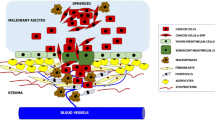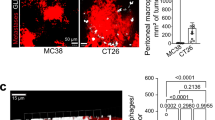Abstract
We investigated the significance of milky spots for malignant cells in peritoneal dissemination using three mouse carcinomatous peritonitis models. P388 leukemia and Colon 26 cancer cells were labeled with bromodeoxyuridine (BrdU) and mice were inoculated intraperitoneally. After 24 h the greater omentum and the mesenterium were removed and stained immunohistochemically with anti-BrdU antibody. The labeled cells were found to have preferentially infiltrated into the milky spots in these specimens. Next, using B16 PC melanoma cells, which can be easily distinguished from the other cells by the intrinsic black melanin, the distribution of the melanoma cells was observed macro- and microscopically following intraperitoneal inoculation. The melanoma cells were similarly found to have selectively infiltrated into the milky spots in the omentum and mesenterium after 1 day. Moreover, the melanoma cells were growing and forming distinct metastic lesions within the milky spots 1 week later.
Similar content being viewed by others
References
Beelen RH, Fluitsma DM, Hoefsmit ECM (1980) The cellular composition of omentum milky spots and the ultrastructure of milky spot macrophage and reticulum cells. J Reticuloendothel Soc 28: 585–599
Corbett TH, Griswold DP Jr, Roberts BJ, Peckham JC, Schabel FM Jr (1975) Tumor induction relationships in development of transplantable cancers of the colon in mice for chemotherapy assays, with a note on carcinogen structure. Cancer Res 35:2434–2439
Dawe CJ, Potter M (1957) Morphologic and biologic progression of a lymphoid neoplasm of the mouse in vivo and in vitro. Am J Pathol 33:603
Dux K (1969) Role of the greater omentum in the immunological response of mice and rats to the intraperitoneal inoculation of Ehrlich ascites tumor. Arch Immunol Ther Exp 17:425–432
Dux K (1990) Anatomy of the greater omentum and lesser omentum in the mouse with some physiological implications. In Goldsmith HS (eds): The Omentum. Research and clinical applications. Springer, New York Berlin Heidelberg, pp 19–43
Dux K, Janik P, Szaniawska B (1991) Kinetics of proliferation, cell differentiation, and IgM secretion in the omental lymphoid organ of B10/Sn mice following intraperitoneal immunization with sheep erythrocytes. Cell Immunol 32:97–109
Dux K, Shimotuma M, Simpson-Morgan W (1993) Technique for in situ excision distended samples of greater omentum from small laboratory animals. Biotech Histochem 68:46–9
Green JA and Williams AE (1978) The relationship between inflammatory responses and WBP1 tumor cell attachment to the rat omentum. Eur J Cancer 14:1153–1155
Hagiwara A, Takahashi T, Sawai K, Taniguchi H, Shimotsuma M, Okano S, Sakakura C, Tsujimoto H, Osaki K, Sasaki S, Shirasu M (1993) Milky spots as the implantation site for malignant cells in peritoneal dissemination in mice. Cancer Res 53:687–692
Higgins GM, Bain NCG (1930) The absorption and transference of particulate material by the great omentum. Surg Gynecol Obstet 50: 851–860
Seifert E (1921) Zur Biologie des menschlichen grossen Netzes. Arch Klin Cir 116:510–517
Shimotsuma M, Takahashi T, Kawata M, Dux K (1991) Cellular subsets of the milky spots in the human greater omentum. Cell Tisue Res 264:599–601
Tsujimoto H, Takahashi T, Hagiwara A, Shimotsuma M, Sakakura C, Osaki K, Sasaki S, Shirasu M, Sakakibara T, Ohyama T, Sakuyama A, Ohgaki M, Imanishi T, Yamasaki J (1995) Site-specific implantation to the milky spots for malignant cells in peritoneal dissemination-immunohistochemical observation in mice inoculated intraperitoneally with bromodeoxy-uridine labeled cells. Br J Cancer 71:468–472
Tsuruo T, Naganuma K, Iida H, Tsukagoshi S (1980) Lymph node metastasis and effects of 1-β-d-arabinofuranosylcytosine, 5-fluorouracil, and their lipophilic derivatives in an experimental model system using P388 leukemia. Cancer Res 40:4758–4763
Author information
Authors and Affiliations
Additional information
This work was supported in part by a Grant-in-Aid from the Ministry of Education, Science, and Culture of Japan
Rights and permissions
About this article
Cite this article
Tsujimoto, H., Hagiwara, A., Shimotsuma, M. et al. Role of milky spots as selective implantation sites for malignant cells in peritoneal dissemination in mice. J Cancer Res Clin Oncol 122, 590–595 (1996). https://doi.org/10.1007/BF01221190
Received:
Accepted:
Issue Date:
DOI: https://doi.org/10.1007/BF01221190




